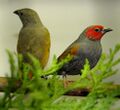Biology:Pytilia
From HandWiki
Short description: Genus of birds
| Pytilia | |
|---|---|

| |
| Green- and Orange-winged pytilias | |
| Scientific classification Error creating thumbnail: Unable to save thumbnail to destination
| |
| Domain: | Eukaryota |
| Kingdom: | Animalia |
| Phylum: | Chordata |
| Class: | Aves |
| Order: | Passeriformes |
| Family: | Estrildidae |
| Genus: | Pytilia Swainson, 1837 |
| Type species | |
| Pytilia phoenicoptera red-winged pytilia Swainson, 1837
| |
Pytilia is a genus of small brightly coloured seed-eating birds in the family Estrildidae. They are distributed across Africa.
Taxonomy
The genus Pytilia was introduced in 1837 by the English naturalist William John Swainson for the red-winged pytilia.[1][2] The name Pytilia is a diminutive of the genus Pitylus that had been introduced in 1829 by the French naturalist Georges Cuvier for the grosbeaks.[3] A molecular phylogenetic study has shown that the genus is basal to a clade containing the twinspots in the genera Euschistospiza, Hypargos and Clytospiza and the firefinches in Lagonosticta.[4]
Species
The genus contains five species:[5]
| Image | Common Name | Scientific name | Distribution |
|---|---|---|---|
| Orange-winged pytilia | Pytilia afra | Angola, Botswana, Burundi, the Republic of Congo, the Democratic Republic of the Congo, Ethiopia, Kenya, Malawi, Mozambique, Rwanda, South Africa, South Sudan, Tanzania, Uganda, Zambia and Zimbabwe | |
| Red-winged pytilia | Pytilia phoenicoptera | Benin, Burkina Faso, Cameroon, Central African Republic, Chad, The Democratic Republic of the Congo, Côte d'Ivoire, Ethiopia, Gambia, Ghana, Guinea, Guinea-Bissau, Mali, Niger, Nigeria, Senegal, Sierra Leone, Sudan, Togo and Uganda | |
| Red-billed pytilia | Pytilia lineata | Ethiopia | |
 |
Green-winged pytilia | Pytilia melba | Sub-Saharan Africa |
 |
Yellow-winged pytilia | Pytilia hypogrammica | Benin, Burkina Faso, Cameroon, Central African Republic, Chad, The Democratic Republic of the Congo, Côte d'Ivoire, Ghana, Guinea, Liberia, Nigeria, Sierra Leone and Togo |
References
- ↑ Swainson, William John (1837). The Natural History of the Birds of Western Africa. 1. Edinburgh: W.H. Lizars. p. 203. https://archive.org/details/bub_gb_FAwAAAAAQAAJ/page/n270/mode/1up.
- ↑ Paynter, Raymond A. Jr, ed (1968). Check-List of Birds of the World. 14. Cambridge, Massachusetts: Museum of Comparative Zoology. p. 312. https://www.biodiversitylibrary.org/page/14481513.
- ↑ Jobling, James A. (2010). The Helm Dictionary of Scientific Bird Names. London: Christopher Helm. p. 327. ISBN 978-1-4081-2501-4.
- ↑ Olsson, Urban; Alström, Per (2020). "A comprehensive phylogeny and taxonomic evaluation of the waxbills (Aves: Estrildidae)". Molecular Phylogenetics and Evolution 146: 106757. doi:10.1016/j.ympev.2020.106757.
- ↑ Gill, Frank; Donsker, David; Rasmussen, Pamela, eds (July 2021). "Waxbills, parrotfinches, munias, whydahs, Olive Warbler, accentors, pipits". IOC World Bird List Version 11.2. International Ornithologists' Union. https://www.worldbirdnames.org/bow/waxbills/. Retrieved 13 July 2021.
Wikidata ☰ Q1093273 entry
 |

